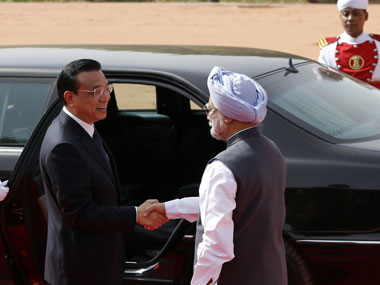Chinese official media may have faithfully echoed the storyline for Premier Li Keqiang’s recent visit to India, but independent commentators are casting a skeptical look at the things that unite the two countries - in an unflattering way.
The official Xinhua news agency noted that Premier Li had concluded the Indian visit with a “strategic consensus”, and “deepened strategic trust”. That sentiment channelled Li’s characterisation of what he called the “most important outcome” of his talks with Indian leaders.
[caption id=“attachment_806455” align=“alignleft” width=“380”]
 Li Keqiang and Prime Minister Manmohan Singh. Reuters[/caption]
Li Keqiang and Prime Minister Manmohan Singh. Reuters[/caption]
The official media further claimed that Li’s visit had helped to transcend the “media hype” over the recent border tension in the Ladakh region. The hypernationalist - and typically shrill -Global Times newspaper observed editorially that “inspite of media hype”, both sides shared a “common will in terms of preventing border problems from impeding Sino-Indian ties.”
For perhaps the first time, media commentaries in China are making the important concession that Indian perceptions and fears about China needed to be understood and acknowledged. “Chinese people,” one commentary noted, “lack understanding and respect toward India. They tend to judge it according to ill-conceived preconceptions.”
It was in China’s own interest that its relationship with India enabled the build-up of mutual trust.
Referencing China’s maritime disputes in the East China Sea and in the South China Sea (where China claims soveriengty over many disputed islands and waterways), the media pointed out that “China’s surrounding environment will suffer if India, a country which has the prospect of running neck-and-neck with China, becomes another Japan on Philippines in terms of its policies toward China.”"
Impact Shorts
More ShortsLikewise, Chinese commentator Wang Dehua, director of the Institute of South Asia and Central Asia Studies at the Shanghai Municipal Center for International Studies, has emphasised that China should do its utmost to retain India as an ally, particularly since, in China’s perception, it is the target of a “containtment” strategy crafted by the US.
India, he noted, can also serve as a balance of the Us ‘pivot to Asia’ strategy. That is a reference to the foreign policy reorientation that US President Barack Obama engineered in 2011 to re-engaged with the Asia-Pacific region, which had fallen off the radar during the George W Bush years, because of the obsession with the “war on terror”, which tied down the US in West Asia and the Af-Pak region.
These observations in the official Chinese media amount to a significant change in the Chinese perception about India, which had earlier tended to be dismissive of India’s aspirations to being an emerging power that claimed equal standing on the world stage alongside China.
They validate the wisdom of the open-hearted articulation by the Indian side of the contentious issue that cast a shadow on the bilateral relationship, rather than seek to play it down in the belief that it would “hurt the feelings of the Chinese people.” Firstpost has long argued that walking on eggshells with China is a losing proposition, and that in fact by dwelling excessively and exclusively on the “thousands of years of civilizational history” that the two countries share, the Indian side was not being sensitive to the changing power dynamics of Chinese foriegn policy formulatio as China engages more and more with the world.
Independent commentators, however, have pointed to the fact that China and India are united in another way - but it is far from flattering. China and India may be very different countries with very different economies, but in fact they share disquieting parallels, notes economic commentator Tom Holland.
In India, as in China, the danger is that too much government involvement in the economy may stile future progress. And therefore, leaders in both countries must push through far-reaching structural reforms in the face of stiff opposition from well-entrenched interests within their own domestic power structures, notes Holland.
In his estimation, if the two countries failed to bite the bullet on structural reforms, the two countries could well fall into the dreaded middle-income trap of stalled development.
Li, who will be China’s foremost economic manager for the next decade, focussed much of his India visit on potential economic gains that would accrue to mutual advantage if the two countries advanced their trade relationship. Such a relationship would make the two countries the “new engine of the global economy”.
That consideration is not without merit, but to get there, both India and China have to climb the mountain trust - and carry out economic regforms. That mountain, as events of the past month demonstrated, can often be higher than the Himalayas…
)